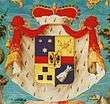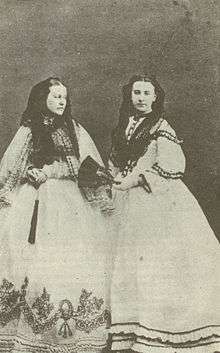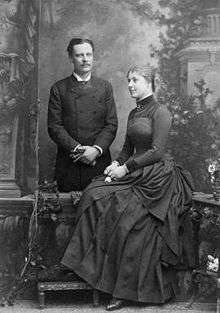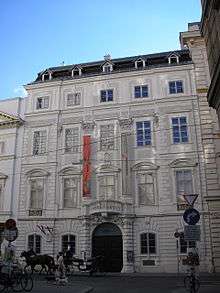Clary und Aldringen
| Clary-und-Aldringen | |
|---|---|
 | |
| Country |
|
| Titles | |
| Founded | 1634 |
| Founder | Hieronymus von Clary and Ana Maria von Aldringen |
| Current head | Prince Hieronymus von Clary und Aldringen (b. 1944) |
Clary und Aldringen or Clary-Aldringen is one of the most prominent Austro-Hungarian princely families. Of dual Bohemian and Catholic Dutch noble origin, it possessed enormous riches and extended estates in Bohemia and Austria and produced several notable Austro-Hungarian statesmen, military officers and diplomats.
Origin
The Bohemian princes of Clary und Aldringen descend from two noble families of the Holy Roman Empire. On the one hand, the von Clarys, lords of Riva del Garda, are Upper-Italian nobles who entered the Bohemian nobility in the 14th century. On the other hand, the von Aldringens are a catholic noble family from the Spanish Netherlands who sided with the Habsburgs during the Reformation and the subsequent religious wars. In 1622, countess Anna Maria von Aldringen, sister and heir of Thirty Years War's Austrian general Reichsgraf Johann von Aldringen, married count Hieronymus von Clary, son of Bohemian lord Franz von Clary. Their descendants were allowed by imperial decree to adopt the name and arms of both families. Ever since, they are named Clary und Aldringen (or Clary-Aldringen).
Illustration


In the Austrian Empire
The princes von Clary-Aldringen have been one of the most prominent family of the Austrian Empire and the Kingdom of Bohemia.
The rise of the family started when Franz von Clary left his ancestral lands in Trentino to settle in the Kingdom of Bohemia where his family was known since the 14th century. In 1623, Clary bought properties in the Ústí nad Labem region. But it is the inheritance of Johann von Aldringen's estates through Franz's son's wife, Anna Maria von Aldringen, that has made the Clary-Aldringens one of the most influential and wealthy Bohemian noble family.
Indeed, in 1634 Johann had received from Emperor Ferdinand II the ownership of the lands in and around the wealthy city of Teplitz (Teplice)[1] only to die the same year without any heir but his sister Anna Maria. The inheritance was disputed but Emperor Ferdinand II recognized the Clary-Aldringens as legitimate heirs of Teplice, making them the most powerful nobles of the Sudetes. Consequently, the rise of the family sped up and, in 1666, the Clary-Aldringens were raised to the rank of Count of the Holy Roman Empire by Emperor Joseph I. Soon after, they bought huge estates in Tyrol; and in 1693 were acknowledged there as a Landmann family – without noble ancestry, but deserving of respect because of the extent of their possessions.
In 1767, imperial Treasurer and Emperor Joseph II's private council member Reichsgraf Wenzel von Clary und Aldringen, is raised to princely rank and the Clary-Aldringens are mediatized. Members of the family became hereditary members of the Austrian Reichsrat (or Imperial Council). From that date, the princely title (Prince/Fürst von Clary und Aldringen) is borne by the head of the family (styled Durchlaucht (Serene Highness)) while junior members bear the title of Counts/Graf or Countess/Grafin von Clary und Aldringen (styled Erlaucht (Illustrious Highness)).
During the Napoleonic Wars, the family's Teplitz castle was the headquarters of the Sixth Coalition against Napoleon, uniting Austria, Prussia and Russia. There was first signed the triple alliance against Napoleon I of France that led to the coalition victory at the nearby Battle of Kulm and eventually instated the Holy Alliance officially signed in Paris on September 26, 1815. During the rest of the century, the family hosted royals several times at their Teplitz castle: in 1835, they received King Frederick William III of Prussia, Emperor Nicholas I of Russia and Emperor Franz I of Austria; in 1849, they received Emperor Franz-Joseph and Kings Frederick William IV of Prussia and Frederick-August II of Saxony; in 1860 they received the Emperor and the prince-Regent William of Prussia.
During the late 19th century, the princely family kept a great influence within Austro-Hungarian elites (the 100 Hoher Adle Familien) and thus played an important role in politics and diplomacy as illustrated by prominent Austro-Hungarian diplomat Prince Siegfried (1848–1929) and his brother prominent Austrian statesman Count Manfred (1852–1928).
Nowadays
Since 1945 when the Czechoslovak government confiscated their Bohemian ancestral estates, the family has lived in Frankfurt, Germany and Venice, Italy. Since March 2007, the head of the family is Hieronymus, 9th Prince of Clary and Aldringen (born in 1944).
Notable members
- Reichsgraf Johann von Aldringen (1584–1634), commandant of the Austrian army during the Thirty Years War
- Prince Wenzel von Clary und Aldringen, first prince Clary-und-Aldringen
- Princess Elizabeth-Alexandrine von Clary-und-Aldringen, née Countess de Ficquelmont, daughter of Count Charles-Louis and Countess Dorothea de Ficquelmont, née Tiesenhausen
- Prince Siegfried von Clary-Aldringen (1897–1920), prominent Austro-Hungarian ambassador; son of the previous one
- Count Manfred von Clary-Aldringen (1852–1928), Austro-Hungarian statesman, Governor of Austrian Imperial Lander of Silesia and Styria, minister-president of the Austrian part of Empire (1889); and brother of the previous one
Residences
_Teplick%C3%BD_z%C3%A1mek_-_Teplice_517-14_B.jpg)


The Clary-Aldringens were great landowners, therefore they possessed enormous estates in Bohemia, Tyrol and Austria.
The most important of all of their estates was that of Tepliz that comprised the eponymous city as well as more than 70 towns and villages, it was the larger noble estate of the Sudetes and one of the largest private property of Bohemia before its confiscation according to the Beneš decrees.
In consequence, the Clary-Aldringens had many residences, the grandest being:
- Schloss Teplice (Teplice Palace) that has been the primary seat of the family from the 16th century to its confiscation in 1945;
- Palais Mollard-Clary, the family palace in Vienna;
- Palais Clary in Prague;
- Palazzo Clary, Venice; to this day owned by the present prince.
- Schloss Herrnau (Herrnau Castle) in Salzburg; to this day owned by a younger branch of the counts of Clary-Aldringen.
Dubí's St-Mary's Church was built on the order of the Clary-Aldringens between 1898 and 1906 as a copy of the Venice church Santa Maria dell'Orto to become their new family Church.
Marriages
The Clary-und-Aldringens are tied with the Radziwill, Glam Gallas, Mensdorff-Pouilly, Ficquelmont, Pejácsevich, de Baillet-Latour, Kinský, Stromberg, Donnersmarck, Hohenzollern[-Hechingen], etc.
Bibliography
- Alfons Clary Aldringen, History of an old Austrian, Ullstein, Frankfurt, 1977, ISBN 3-550-07474-3
- Diana Mosley, Prince and Princess Clary. Loved Ones, London 1985, pp. 132-153, ISBN 0-283-99155-0
- Genealogy of princes Clary-Aldringen since the early 19th centyury on Gotha website
References
- ↑ the Emperor had taken these lands away from the protestant Kinsky family
